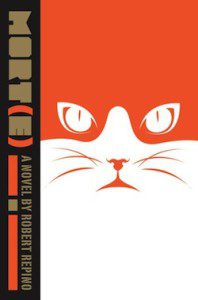
Following his return from North Korea, Christopher Hitchens gave a speech expressing his fear about resorting to a critical cliché: “I know what I’m not going to say about North Korea, I’m not going to say it… They won’t make me say 1984, they just won’t make me do it.”
“But eventually,” he declared, “they make you do it.”
I don’t know when, on my youthful tear through Hitchens’s work, I discovered this excerpt, but I had forgotten it until I read Robert Repino’s debut science-fiction novel, Mort(e). Finishing Repino’s book, I made a similar proclamation, stubbornly swearing I’d make as few references as possible to Animal Farm: I wouldn’t claim Repino’s drunk, daft pig Bonaparte to be a subversion of Orwell’s shrewd Comrade Napoleon, and I wouldn’t insist, despite the likeness, that the animals of Mort(e) and those under Mr. Jones’ tyranny all strive to free themselves from the bonds of human-imposed slavery. But I couldn’t help myself: They made me.
There’s something about personified animals that elicits comparisons: Within the first few pages, I was thinking of Netflix’s Bojack Horseman, Alice in Wonderland, and the Old Testament. And as odd as it sounds, there are different schools of thought when it comes to anthropomorphism: There’s the allegory, the fairy tale, the fable. There’s the idea, too, of grounding these narratives in alternative realities, where human beings and animals live, if not harmoniously, then together, with the same concerns and emotions and tendencies. (Brian, the rational dog in Family Guy, has opposable thumbs, and no one ever appears baffled.) Like Animal Farm, Mort(e) is a funny and clever mix of these frameworks. It’s a post-apocalyptic story about the prevailing love between two neighboring pets and the animal kingdom’s attempted extermination of the human race. But it’s also a blatant critique—a denouncement not of the Russian Revolution and its aftermath but of the pitfalls in believing in God and an afterlife.
Mort(e) reads as a recorded history, as both the retelling of a catastrophe—a centuries-long plot by giant, super-intelligent ants to defeat the human rulers—and as the origin story of a religion. The novel opens with the concise and unadorned language of the Bible:
Before he took his new name, before the animals rose up and overthrew their oppressors, before there was talk of prophecies and saviors, the great warrior Mort(e) was just a house cat known to his human masters as Sebastian.
What unfolds is a 350-page expansion of that first line, told in a sarcastic and sometimes caustic style by a young writer of promising talent—by which I mean, a talent that is promised on the first page and then, after a series of ant mythologies, feline war tragedies, and inter-species friendships, firmly established by the end.

Repino’s protagonist, Sebastian, belongs to the Martini family (Daniel and Janet and their children, Michael and Delia), and he spends most of his days lounging “in the square of sunlight on the [living room] carpet” and secretly scouring the attic. His life passes by in solitary ecstasy, but all of that ends “when Janet start[s] sleeping with the next-door neighbor,” Tristan. In order to keep the affair hidden, and to prevent a barking outburst in his front yard, Tristan brings his loyal dog, Sheba, into the Martini’s home. Sebastian and Sheba explore the house together, and when tired, they sleep, nestling for warmth.
And then one day, Sebastian—and the rest of Earth’s animals—attains “self-awareness.” They are able to walk on their hind legs, speak (English), and kill their “masters.” After a semi-violent confrontation with the Martinis, Sebastian sets off to rediscover his “lost love,” Sheba, who has reportedly run away after the “Change.” Mort(e) is riddled with the usual ambiguous nouns that arrive at the onset of widespread destruction: Responsible for the “Change” and the “war with no name” is a race of intelligent ants known as the “Colony,” and their leader is the “Queen,” a gigantic insect who can view the past, present, and future. She controls everything, like an all-seeing God, and she communicates between species by use of a “translator,” a helmet-like object that transfers her knowledge—with almost crippling results—to the wearer.
In the search for his friend, Sebastian joins “The Red Sphinx,” a squad that helps fight the surviving homo sapiens. Under the command of Culdesac, a once-wild bobcat, he forms a reputation for bravery, and over the course of many years he confronts the mysterious human bio-weapon EMSAH. As part of his initiation into the group, Sebastian must pick a new name. He lands on “Mort(e),” borrowed from a term “meaning death”:
He had died. He had killed. And he would kill again. So the name fit. But it could also be a normal name, the name of a regular guy named Mort who was meant for a life surrounded by loved ones. That life was still out there, but it would have to wait. Hence the need to keep the letter in parentheses. Things could go either way.
Sebastian takes immense care in renaming himself (Culdesac’s second-in-command, a pit bull, chooses Wawa, the first word she reads plastered on a storefront) and there are obvious parallels between his decision and the novel’s themes, especially between his shifting identities (a war hero and a “normal” cat) and the notion of love trumping all else. The name straddles life and death, and this tension comes to define his existence: whether he will keep living in order to find his old pal, or whether he will remain a pawn in the ants’ plan for domination and die a soldier.
To his credit, Repino packs tons of detail and background into Mort(e), and everything operates, for the most part, in service of the whole. But the text turns dense and saturated at times, and I felt, more than once, like I was wearing a translator on my head, receiving a sensory overload from the omniscient Queen. Within the great trove of technical information regarding the ants’ behavior, certain inconsistencies—plot holes, flat characters, mixed-up motivations, omitted explanations—become apparent. How are the ants so quickly able to “adapt” to chemical agents? How do some humans build an Atlantis-like community on a blimp? What happened to the country’s leaders?
Perhaps most troubling, however, is why so many of the remaining human beings are Christian. Where are the Atheists? The Buddhists? The Hindus? Although Repino’s focus on the formative stages of a religion is captivating (the remaining human resistance believes Mort(e) to be the Messiah), it’s muddled by allusions to Christ and demeaned by the absence of other belief systems. The overt Christianity isn’t completely unacknowledged—Culdesac assures that “not all of them think this way”—but it is a flaw, and it points to a larger mistake: The book has no definite sense of place. It left me wondering, in a world where pigs undergo plastic surgery (a nice touch), why no specific city is ever mentioned. A sense of the area would have solved the issue of why there are only a discrete number of animals featured as well: Where Orwell benefited from limiting himself to farm animals, Repino doesn’t narrow his scope. I was a little upset there was never a giraffe walking around on his two feet.
Yet despite the occasional lapse, Repino never loses sight of his overarching purpose: He desperately wants to convince us this could actually happen, and he seems to know there’s an inherent humor and fear in believing that animals can rise up and slit our throats. (Richard Dawkins predicts it’ll be rats, not ants.) But Mort(e) is not a cautionary tale, and it does not, as may initially be the case, wholly denounce religion. It’s not a warning about how dictatorial pigs and dictatorial humans become indistinguishable. Instead Repino is interested in showing us, if events like these were to somehow transpire, the one shred of hope that would exist.




